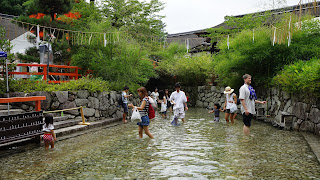I guided family from Israel to the Sigureden-museum located in Arashiyama where you can enjoy the Japanese aristocrat costumes. The prepared ladies costumes are called “Uchigi” which was worn daily by noblewomen. “Uchigi” literally means clothing that is worn over other clothes. My guests put on it over their T-shirt with the assistance of museum volunteer. She directed us to make the atmosphere of Heian aristocrat court life. Without her help, I couldn’t take such nice pictures.
Father
of gust family enjoyed wearing “Kariginu” which literally means hunting suit.
It is worn daily by noblemen as casual clothes. Men’s attire here is time
consuming work than women’s because you have to put on not only “Kariginu” but
aloso the traditional trousers called “Hakama” and ancient coronet called “Eboshi”.
After
the Sigureden museum, we headed to Otagi-Nenbutsuji temple by taking taxi. It
is located a little bit far from the Togetsu-kyo bridge. There was no visitors
except for us as well as in the Reiun-in temple.
Stone
statues here are carved by worshipers from all over Japan. They made their
original statues, some are playing the traditional flute and some are holding
tennis rackets or baseball bat. Those statues brought peace to the hearts of us.
In
such tranquil environment, we can talk various topics and that is not always
related with sightseeing and culture. I was asked about the Japanese Self
Defense Force and we talked the difference of our military system. One of my
guest served in military service as officer several years ago and I could
hardly image it. Japanese isn’t liable to military service. Compared to their
homeland, Japan is definitely peaceful country .
Japanese takes it for granted but "Peace" must be the one of the important factor to attract the foreign visitor.
Japanese takes it for granted but "Peace" must be the one of the important factor to attract the foreign visitor.









